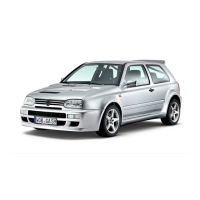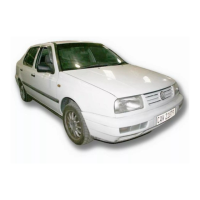Do you have a question about the Volkswagen 1200 and is the answer not in the manual?
Procedure for checking the engine oil level using the dipstick.
Procedure and specifications for checking the tension and condition of the V-belt.
Details on fuel tank capacity, fuel gauge operation, and reserve fuel.
Guidance on tire maintenance, recommended pressures for various loads.
Instructions for checking the condition and application of the vehicle's brakes.
Explanation of headlight beam control and parking/tail light functions.
Step-by-step guide for starting the engine, including cold and warm conditions.
Procedure for smoothly moving the car forward from a standstill.
Instructions for shifting between gears and to reverse.
Procedure for bringing the vehicle to a complete stop and turning off the engine.
Information on whether initial speed restrictions are necessary for the Volkswagen.
Tips for maximizing fuel economy through driving style and gear selection.
Guidance on driving at high speeds without sacrificing fuel economy.
Features of the car for winter driving comfort and visibility.
Recommendations for engine oil types and changes based on cold temperatures.
Advice on transmission oil grades for use in cold weather.
Measures to protect the chassis from moisture and reduce ice formation.
Precautions for parking the car in freezing conditions.
Tips for preventing and dealing with frozen door locks in winter.
Advice on tire wear, M+S tires, and chains for winter conditions.
Information on battery strain and maintenance during cold weather.
Adjusting spark plug gaps to aid cold starting.
Importance and procedure for regular engine oil changes.
Procedure for cleaning the oil strainer during oil changes.
Explanation of different SAE viscosity grades for engine oils.
Instructions for changing and maintaining transmission and differential oil.
Type of lubricant and procedure for the steering gear.
Locations and intervals for chassis lubrication points.
Lubrication of seat runners for smooth movement.
Lubrication of the joints in the convertible top linkages.
Step-by-step guide for changing a wheel and replacing a tire.
Importance of static and dynamic wheel balancing for smooth running.
Importance of keeping the car clean for appearance and paint finish.
Proper methods for washing the car's exterior, wheels, and chassis.
Procedure for applying wax to protect and restore the car's finish.
Guidelines for polishing the car's paintwork to restore lustre.
Methods for removing tar, oil, and insect spots from the car's finish.
Instructions for cleaning the sun roof, including material care.
Maintaining the appearance and service life of the convertible top.
Procedure for cleaning and servicing the air cleaner element and reservoir.
Steps to adjust or replace the fan belt and ensure proper tension.
Procedure for cleaning the fuel pump filter to prevent carburetor issues.
Guidelines for adjusting carburetor idling speed; other adjustments by workshop.
Procedure for adjusting valve clearance when the engine is cold or warm.
Inspection of spark plugs for engine condition and performance indicators.
Importance of correct ignition timing and procedure for setting it.
Regular checks and maintenance for the car battery's condition.
Procedure for vertically adjusting headlight beams for proper road illumination.
Procedure for horizontally adjusting headlight beams to align with road markings.
Steps for safely replacing headlight bulbs and checking lamp units.
Details on brake adjustment, fluid reservoir, and fluid type.
Procedure for removing air from the hydraulic brake system.
Procedure for adjusting foot brake shoe clearance and pedal travel.
Steps for adjusting the hand brake cable tension for proper engagement.
Procedure for adjusting the clutch pedal free-play for smooth gear shifting.
Information on the car's frame construction and suspension system.
Detailed specifications for the engine, including bore, stroke, capacity, and compression.
Details on the transmission, gear ratios, and rear axle power transfer.
Overview of the hydraulic foot brakes and mechanical hand brake system.
Description of the car's body structure, ventilation, and luggage space.
How the interior heating system operates and is controlled.
Data on wheel size, tire specifications, and inflation pressures.
Key vehicle dimensions, unladen weight, and load capacities.
Table detailing lubricants, lubrication points, and temperature/viscosity specifications.
Chart outlining maintenance operations and their recommended service intervals.
| Brand | Volkswagen |
|---|---|
| Model | 1200 |
| Category | Automobile |
| Language | English |











